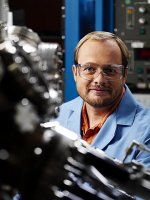Science magazine spotlights new method that boosts catalyst's performance
(October 2008)
Congratulations to Zdenek Dohnálek, Jooho Kim, and Bruce D. Kay at Pacific Northwest National Laboratory's Institute for Integrated Catalysis on having their research highlighted in the September 26, 2008, issue of Science. This weekly journal by the American Association for the Advancement of Science is one of the world's most prestigious scientific publications.
The journal highlighted the team's studies on palladium, an expensive metal that speeds the making of useful molecules. However, palladium does not do well at adding hydrogen at low pressure or in a vacuum. As an example, look at the model reaction for hydrogen addition or hydrogenation: adding two hydrogen atoms to ethylene to get ethane. When palladium catalyzes this reaction in a vacuum, less than 1 percent of the ethylene is converted to ethane, an unacceptable rate.
So, the team designed a palladium catalyst that converts 50 percent of the ethylene to ethane at low pressure, an order-of-magnitude improvement. The team designed this highly effective catalyst by directing a beam of the palladium atoms onto a surface held at an oblique angle to the beam. This was done in extreme cold.
Using this process, the atoms formed tiny hills and valleys on the surface. The cold temperature allowed the atoms to stay where they landed, building up the hills. The landscape meant more of the atoms were on the surface and not in the bulk of the material. This provided two distinct advantages to the catalyst. First, more highly reactive palladium atoms were available to react on the surface. Second, the catalyst had very little bulk, so the hydrogen atoms stayed on the surface and participated, instead of dissolving into the bulk.
To read the news highlight in Science, see "More Surface, More Reactivity" on page 1742 of the September 26, 2008 issue.
Acknowledgments: The U.S. Department of Energy Office of Basic Energy Sciences, Chemical Sciences Division funded the research.
The research, including the scanning electron microscopy work, was done in DOE's EMSL, a national scientific user facility at PNNL.


